The History Of Cadillac Seville

The Cadillac Seville is a luxury car that was manufactured by the Cadillac division of American automaker General Motors as a limited production specialty model in the 1950s and 60s. It was traditionally second in the Cadillac lineup after the top of the line Eldorado, and more focused on technology than the sales-leader Deville. Reintroduced as a regular production vehicle from 1975 to 2004, the Seville was a smaller format top of the line Cadillac.
The first use of the Seville name was on a hardtop version of the 1956 Cadillac Eldorado convertible. Four Eldorado Seville 4-door hardtops were built in 1957, but it is the outlandish tailfins found on the 1959 model that are most remembered. 1960 was the last year for the Eldorado Seville.
Various names were considered for what became the next generation Seville. Resurrection of the LaSalle nameplate was seriously considered, but it was decided that given that LaSalle had been used for entry-level sub-Cadillacs in the past; it would create confusion in the marketplace among those who recollected the context of the names previous use.
The Seville introduced in 1975, was Cadillac's answer to the rising popularity of luxury imports in the US from Europe, such as Mercedes-Benz and BMW. Historically, these imported luxury cars had been cheaper, less luxurious and significantly smaller than Cadillacs. Over time they had evolved, becoming quite luxurious and even more expensive than the much larger Cadillacs. As the market share of these imports continued to climb, it became obvious that the traditional American automotive paradigm of "bigger equals better" was no longer in full effect in the marketplace. The Seville became the smallest and most expensive model in the lineup, turning Cadillac's traditional marketing and pricing strategy upside down.
Initially based on the rear-wheel drive X-body platform that underpinned the Chevrolet Nova (a unibody with a bolt-on subframe — this layout was common with both GM X and F bodies), the Seville's unibody and chassis were extensively re-engineered and upgraded from that humble origin and it was awarded the unique designation of "K-body". Cadillac stylists added a crisp, angular body that set the tone for GM styling for the next decade, along with a wide-track stance that gave the car a substantial, premium appearance. A wide chrome grille flanked by quad rectangular headlamps with narrow parking and signal lamps just below filled the header panel, while small wrap-around rectangular tail lamps placed at the outmost corners of the rear gave the appearance of a lower, leaner, and wider car. The wrap-around taillights might have came from a design sketch of a Coupe DeVille concept which was rejected (the concept can be seen in the March 2008 issue of Collectible Automobile detailing the 1977 GM full-size cars).
Seville engineers chose the X-body platform instead of the German Opel Diplomat in response to GM's budget restrictions — GM executives felt that reengineering a German Opel would be more costly than the corporate X-car. Another proposal during the development of the Seville was a front-wheel drive layout similar to the Cadillac Eldorado. This proposal also met with budget concerns since the transaxle used for the Eldorado was produced on a limited basis solely for E-body (Eldorado/ Toronado) production, alongside the GMC motorhome of the mid-1970s (which has a derivative of the E-platform drivetrain).
This was the first time Cadillac began engineering one of its vehicles based on components previously used in a Chevrolet model.
Introduced in mid-1975 and billed as the new "internationally-sized" Cadillac, the Seville was almost 1,000 lb (450kg) lighter than the hulking Deville; nimble, easy to park, attractive and loaded with the full complement of Cadillac gadgets. More expensive than every other Cadillac model at US$12,479, the Seville was a smash hit, and spawned several imitators, such as the less-than-successful Lincoln Versailles, and later the Chrysler LeBaron/ Fifth Avenue. To ensure the quality of the initial production run of Seville's the first 2000 to come off the production line were identical in color (Georgian silver) and equipment. This enabled workers to "ramp up" to building different configurations.
Early Sevilles produced between April 1975 (a total of 16,355) to the close of the 1976 model year were the first Cadillacs to use the Chevrolet passenger car wheel bolt pattern (5 lugs with a 4.75in (121mm) bolt circle; the 2003-present XLR also uses the Chevrolet pattern). The first Sevilles shared only a strict minority of components with the engineering starting point, the GM X-Body. The rear drums measured 11in (280mm) and were similar to the ones used with the Chevrolet Nova 9C1 (police option) and A-body (Chevelle, Cutlass, Regal, LeMans) intermediate station wagons. Starting with the 1977 model year, production Sevilles used the larger 5 lug — 5 inch bolt circle common to full-size Cadillacs, Buicks, Oldsmobiles, Pontiacs, and 1/ 2 ton Chevrolet/ GMC light trucks and vans. It also received rear disc brakes, a design which would surface a year later as an option on the F-body Pontiac Trans Am.
Under the hood went an Oldsmobile-sourced 350in³ (5.7L) V8, fitted with Bendix/ Bosch electronically controlled fuel injection. This system gave the Seville smooth drivability and performance that was usually lacking in other domestic cars of this early emissions control era. Power output was 180hp, and performance was restrained with the 60mph (97km/ h) sprint taking 11.5 seconds. A diesel 350in³(5.7L) LF9 V8 was added in 1978, but that engine was known to be poor in both performance and reliability.
A unique optional feature available only during the 1979 model year was the Cadillac Trip Computer. This option offered an electronic readout for the speedometer and remaining fuel which replaced the standard needle-type gauges. It also included a host of calculations available at the touch of a button on a small panel located just to the right of the steering wheel. These included miles to empty, miles per gallon, and a destination arrival time, which needed to be programmed by the driver, to estimate arrival time based on miles remaining. This system predated Lincoln's system by one year. A digital instrument cluster was available on the Seville and Eldorado again in their 1981 through 1985 configurations, though the "Trip Computer" was no longer available. This option added US$920 to the price of Seville in 1979.
The Seville Cadillac was manufactured in Iran under the brand name of "Cadillac Iran" during 1970s and 1980s, by Pars Khodro, which was known as "Iran General Motors" in 1970s.
Seville Elegante for 1978
Other Cadillac models had "named" luxury option packages ("d'Elegance"/ "Biarritz") so it was time for Seville-"Elegante". For 1978 this package added a unique black/ silver two-tone exterior paint combination and "perforated-style" leather seats in light grey only. Real wire wheels were also standard as were a host of options. In 1979 a second color combination was added-a two-tone copper shade and a matching leather interior. This option package carried on with the Seville through the 1988 model year. In 1985, a monotone paint combination became available, however the dual-shade combinations (which evolved) remained more popular. The price for this opulence increased over time beginning at US$2600 in 1978 and peaking at US$3995 in 1987.
Seville Gucci for 1979
In 1979 Seville was available with an aftermarket package provided by a Miami-based firm. An agreement with Gucci, the famous leathergoods and clothing company, produced a limited-issue "Gucci Seville". Available in only three colors-white, black, and medium brown-the exterior featured many indicators of the Gucci identity. A vinyl top covering only the "c-pillar" and featuring the famous Gucci interlocking double "G" fabric pattern, the interlocking "G" on the wire wheel covers, a red/ green stripe across the lower edge of the trunk lid, and an interlocking double "G" hood ornament decorated the exterior. Inside, the headrests wore the double "G" pattern with a leather trim, the headliner wore the pattern, and the instrument panel bore the iconic Gucci script above the glovebox. Inside the trunk was a full set of Gucci luggage. The cost of this package pushed the Seville price tag to about US$23,000.
Engines
For the 1980 model year, Cadillac moved the Seville to the 114in (2,900mm) wheelbase K-body platform, based on the front-wheel drive E-body Eldorado, Buick Riviera and Oldsmobile Toronado. Returning to some of the original concepts floated for the 1975 edition (the March 2008 issue of Collectible Automobile featured an early concept of what evolved into the downsized 1977 Cadillac DeVilles and Fleetwoods - one of the concepts which was withdrawn looks similar to the second-generation Seville), stylists created a graceful but controversial bustle-backed body intended to invoke Daimlers of a past era (though British Leyland were building cars with this feature even then), and engineers gave it front wheel drive and independent rear suspension. Again, this spawned stylistic imitators such as the Lincoln Continental and the 1981 Imperial.
The early eighties were also a time of technological advances for Seville, initiating features that would become more traditional in later years. In 1981 "memory seats", a feature not seen on a Cadillac since the Eldorado Brougham, became available again. These seats allowed two memorized positions to be recalled at the touch of a button. Also for '81 was a digital instrument cluster. The "Cadillac Trip Computer" was a precursor to this option in 1979. For the '81-'85 Seville and Eldorado, it was considerably less expensive, at US$200 in '81, but did not contain the features of Trip Computer. "Puncture-sealing" tires were also new for '81. In 1982, Seville offered heated outside rear-view mirrors with the rear defogger option. Inside, a "Symphony Sound" stereo tape system was available. For 1983, a new "Delco/ Bose" stereo cassette system was offered at $US 895. It featured a brushed gold-look front panel and bulbous lower interior door speaker assemblies giving almost an aftermarket installation look to the system. This was also the last year for the availability of an 8-track stereo system for Seville. On the outside, Seville was available with a "Full Cabriolet Roof" treatment option. This option provided a "convertible top" look for the car. Cadillac may have provided this due to the popularity of a similar option, available since 1979, on the Lincoln Continental Mark series automobiles.
In hip hop culture, this generation of Sevilles were known as "slantbacks". Sales were respectable at first, but disastrous experimentations with diesel engines (an Oldsmobile sourced 5.7 V8, plagued with head gasket problems)and the ill-fated 1981 V8-6-4 variable displacement engine,(a sound idea in theory-- however 1980's technology could not make it work reliably) along with poor quality control and lacklustre performance from engines severely detuned to meet more stringent CAFE standards began to erode the Seville's standing in the marketplace. A new but underpowered 4.1 litre V8 was fitted to post 1981 models. Unfortunately it was prone to the block becoming porous and coolant mixing with the oil resulting in catastrophic engine failure. Some later cars were also fitted with the 4.1 litre Buick-derived V6, which was a reliable enough engine but however was not designed for fitment to "full size" cars and performance was rather lacking.
Engines
In 1986, an all-new, much smaller body attempted to combine the crisp angularity of the original Seville with the rounded edges of the new aerodynamic aesthetic. The series featured a transverse mounted V8 driving the front wheels. The smaller size and conservative styling were regarded as bland, and customers stayed away. Despite the lack of popularity, the new Seville/ Eldorado chassis featured an advanced transmission and engine control system that offered EPA MPG figures of nearly 30 on the highway using a small fuel injected V8. The new model featured a worldwide production car first — a computer system that monitored the car's systems and the engine. The BCM/ ECM (Body Computer Module/ Engine Computer Module) was paired with an electronic dashboard using high intensity vacuum fluorescent displays and utilized GM's expertise derived from the acquisition of Hughes Electronics, makers of communications and spy satellites. This expertise was later carried forward to many GM models and brands making GM the leader in cutting edge electronics for automotive use. Unfortunately, with sales way below expectations the new model was considered a disaster, and an exterior refresh was rushed for 1988 as a 1989 model. The big news for 1989 was an introduction of the Seville Touring Sedan with its Touring Suspension. It featured enhanced handling, styling and a unique four place interior. For 1989 the Seville Touring Sedan was renamed Seville STS.
Engines
For 1992, Cadillac delivered a new, much more European-flavored Seville with looks that attracted rave reviews as well as customers. The Seville Touring Sedan was Motor Trend magazine's Car of the Year for 1992. It also made Car and Driver magazine's Ten Best list that year.
The 1993 addition of the Northstar System, including the Northstar quad-cam 32-valve aluminum V8 and a new unequal-length control arm rear suspension to the STS helped put the Seville back on the best seller list.
The rear suspension previously featured a single transverse leaf spring like the Chevrolet Corvette. The wheelbase was back up to 111in (2,800mm) with a 203.9in (5,180mm) overall length.
The Seville was divided into two sub-models:
- The Seville Luxury Sedan (SLS) started with the 4.9L HT-4900 V8 but got a 270hp (200kW) LD8 Northstar V8 for 1994
- The Seville Touring Sedan (STS) also started with the 4.9L HT-4900 in 1992 but was upgraded to the 295hp (220kW) L37 Northstar in 1993
Pricing on both cars was over US$40,000.
In 1997, the Cadillac Catera took over from the Seville as Cadillac's smallest car.
In the film U.S. Marshals, Tommy Lee Jones commandeers a Seville STS. Jewelry thieves in the movie Daylight drive a stolen Seville through Holland Tunnel before crashing into a chemical-laden truck. In the film Heat, Robert De Niro drives a green Cadillac Seville throughout the early parts of the film.
Models
The Seville was updated for 1998 on a new version of the K-body platform based on Oldsmobile's G-body Aurora. The wheelbase was up to 112.2in (2,850mm) but the overall length was down a bit to 201in (5,100mm). The car looked similar to the attractive fourth-generation model, but was considered a leap forward and featured numerous suspension and driveability improvements. The Seville STS (and companion Eldorado ETC) became the most powerful front wheel drive cars on the market at 300hp (224kW). The fully-loaded STS model delivered at an MSRP of $52,075.
The fifth generation Seville was the first Cadillac engineered to be built in both left and right-hand-drive form; and became the first modern Cadillac to be officially imported and sold in South Africa along with other right-hand-drive markets such as the Japan and the United Kingdom. In the past, right-hand-drive Cadillacs were built from CKD kits or special conversion kits shipped to other countries for local conversion.
For 2003 its final year, Seville received a new MagneRide adaptive suspension system. Production of the Seville STS ended on May 16, 2003. The Seville SLS ended on December 5, 2003. After the Seville was discontinued for 2004, it was replaced by the rear wheel drive Cadillac STS. All transverse engine front-wheel drive Sevilles were built in Hamtramck, Michigan.
In the 2000 Film Get Carter, Sylvester Stallone's character drives a 2000 Seville STS which receives major cosmetic and slight body damage in a car chase.
Engines
From Wikipedia, the free encyclopedia
More About Cadillac Seville
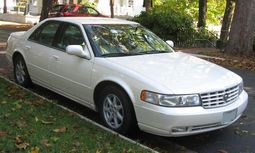
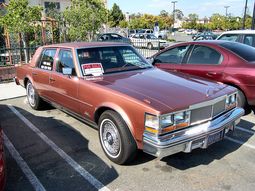
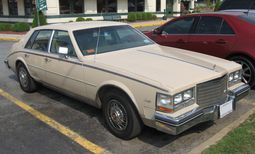
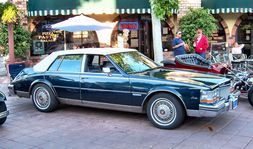
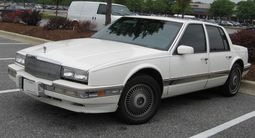
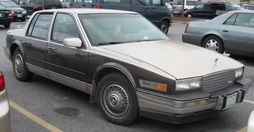
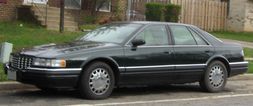
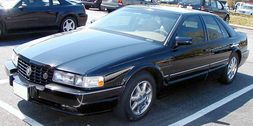
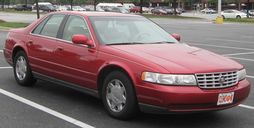
|